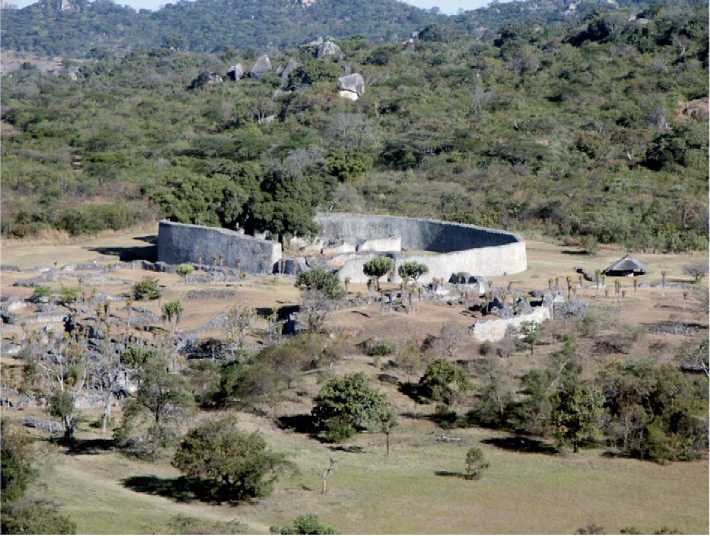During the late first millennium CE, intensive agricultural production and long-distance trade saw the rise of powerful elites who dominated the economy and politics of the region. The interplay of these factors With ideology and ritual led to the establishment of the early states or kingdoms. Mapungubwe, located in the Shashe-Limpopo Basin is but one example. Mapungubwe has dry-stone-walled areas that housed the elite on the hilltop. Ritual objects were used as insignia for political office while prestigious gold objects and glass beads expressed their wealth. Craft specialization was a hallmark of these early kingdoms with metal-working, bead-making, and weaving flourishing. After close to a century of prospering, environmental degradation and shifting trade opportunities occasioned the rise of a more powerful system at Great Zimbabwe some 300 km to the north.
After eclipsing Mapungubwe, Great Zimbabwe controlled long-distance trade with the Indian Ocean

Figure 5 Photograph of the Great Enclosure and Valley enclosures at Great Zimbabwe.
While the Swahili traders acted as intermediaries in a world system that linked widely separated geographical areas of the world. Local products such as gold, cattle, agricultural produce, and ivory, among others, were exchanged for exotic Persian wares, Chinese blue-on-white porcelain, and glass beads. The power and wealth of the ruling elite was invested in very impressive dry-stone-walled structures, the largest stone structures south of the Egyptian pyramids (Figure 5).
Religion was important in the governance of the state and the recovery of skillfully made soapstone birds and ritual objects demonstrates this. The existence of abundant exotic and status goods at Great Zimbabwe when contrasted with the paucity of craft manufacturing evidence adduces that the elites controlled the distribution rather than primary production of goods. Such mechanisms were well supported using tributary modes of production. In a question of history repeating itself, the factors largely responsible for the rise of Great Zimbabwe led toward its demise. A rapidly deteriorating environment and the shifting trade routes led to the emergence of two successor states, the Mutapa in the north and Khami in the southwest by the end of the fifteenth century.
The Mutapa state occupied the northern Zimbabwe plateau and adjacent Zambezi valley lowlands. Archaeology and oral history attest to a continuation of Great Zimbabwe influence. Early Mutapa kings had access to large and exploitable quantities of alluvial and hydrothermal gold, which became an important part of the economy of the state. The gold wealth was invested in monumental architecture and former Mutapa capitals - Zvongombe, Mutota, Kasekete, and Nhunguza - were built in the architectural styles of Great Zimbabwe. The predatory activities of merchant capital represented by the Portuguese traders became the Mutapa’s nemesis. The state ceased to be a significant political player by the late eighteenth century, and by the nineteenth century, was clearly just a mere chiefdom, largely subservient to Portuguese whims.
Another successor state to Great Zimbabwe developed at Khami in the southwestern plateau area. The Torwa state was built and operated along the lines of Great Zimbabwe with the kings living on elaborate dry-stone-walled terraces and in enclosures.
Long-distance trade was an important part of the state and exotic goods have been recovered there. A civil war and Portuguese meddling sounded the death knell to the state leading to the rise of the Rozvi-Changamire state based at Danangombe in the late seventeenth century. The Rozvi-Changamire state was an important political entity, which at one time played the power broker in the Mutapa state. One of its leaders Changamire Dombo is credited with expelling the Portuguese from the plateau, for their gluttonous and belligerent behavior in the Mutapa state. Like most states that arose on the plateau, civil wars caused by succession disputes gradually weakened the state. Successive groups of Nguni people leaving southeastern Africa hastened the collapse of the state with the Ndebele occupying the vacuum arising from the aftermath. On its part, the Ndebele state was highly militarized to prevent annihilation by numerically superior opponents. Using advanced methods of warfare, they managed to subjugate some groups on the plateau. However, the influx of guns from the Portuguese meant that such groups could resist the Ndebele whose state ended with the colonization by the British South Africa Company in CE 1890.
See also: Africa, South: Kalahari Margins; Animal Domestication; Modern Humans, Emergence of; Plant Domestication.




 World History
World History









